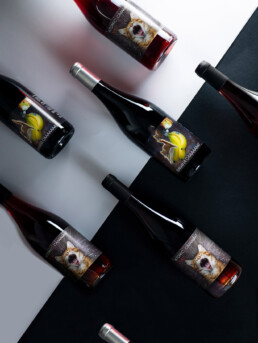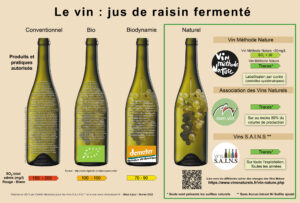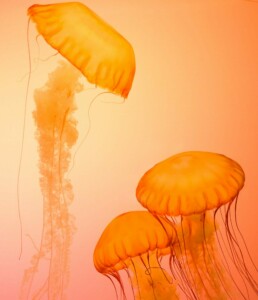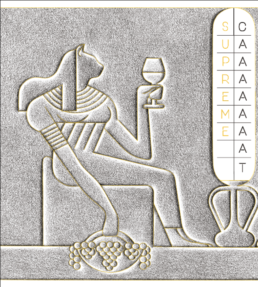What is natural wine?
Simply put
By definition, wine is a cultural product. You can’t stumble across some wine out in the wild, it requires the intervention of a winegrower to make it from grapes (those guys are natural).
So simply put, natural wine is a wine which is made as naturally as possible:
- No synthetic products: not in the vineyards, not in the cellar, anywhere
- Manual harvesting
- A total sulphur/SO2 level lower than 40mg/L
In other words, we aim for pure fermented grape juice. Yes, this should always be the case, but it’s not that simple. Nature is capricious and we don’t follow its rhythm anymore.
A bit of History
The history of naturally produced wine goes back to Antiquity, well before the arrival of 20th century industrial winemaking techniques, which were doubly amplified by the Second World War: the rapid development of petrochemicals (notably for armaments) and the race for yield (during reconstruction).
In France in the 1980s, the movement for a return to natural wine production was spearheaded by such illustrious figures as the Beaujolais "négociant-éléveur" Monsieur Jules Chauvet, who was also a writer, scientist and fine wine taster. Jules Chauvet was a pioneer, one of those rare human beings for whom the adjective "genius" means something. As early as the 1950s, he was producing natural wines. His methods slowly caught on with curious minds such as Jacques Néauport, itinerant wine producer, and the emblematic Beaujolais winemaker Marcel Lapierre (and many others).
During the 90s, the natural wine movement continued to gain popularity in France, Italy and Slovenia, then spread rapidly across Europe and the world (including the USA and Australia) from the 2000s onwards.
Nowadays
Today - as the general public becomes increasingly aware of the benefits that such production brings to their health and that of our environment - many winemakers are converting their vineyards or opting from the outset for healthy agriculture and natural winemaking methods.
The image below summarises the differences in winemaking methods:
And as we are seeing a wave of greenwashing, keep one thing in mind: free wine doesn’t exist. Either we pay with cash, or we pay the price by damaging the environment.
Orange, the fourth color of wine
What is orange wine?
Orange wine, made exclusively from white grapes, is also called “skin-contact” white; a clue to the origin of this orange color coming precisely from the maceration of the skins with grape juice. Orange wine is therefore a white wine vinified like a red!
While for the majority of modern white wines, the grapes are directly pressed, those used for orange (and red) wine macerate with the skin, seeds, and sometimes stems, for a duration ranging from several days to several months. This maceration, this contact with the solid parts of the grape, gives white wine its orange color.
Origins
Contrary to what's often heard, orange wine is not a new trend. It's an ancient practice, with its modern revival dating back to the 1990s, in the Friuli-Venezia Giulia region, specifically in its cross-border area with Slovenia. The major winemakers behind this revival are Slovens: Gravner, Radikon, and Vodopivec. Since then, many wine producers have followed in their footsteps... including Caaaaaaat!
So, the first white wines were orange wines. It's difficult to pinpoint exactly when they appeared, as it seems these wines existed even before writing (which goes to show how far from a new trend this is). However, it's likely that the origin of orange wine can be traced back to Georgia – known for its terracotta amphora winemaking (qvevri), still practiced today – and then integrated into the winemaking methods of Antiquity. During this period, wine preservation was achieved through the addition of exogenous materials (pine resin, honey...) and/or prolonged maceration to extract the famous polyphenols, powerful antioxidants, from the grapes.
Today
It's not by chance that orange wine is reborn in the realm of natural wines. Tradition is alive, in perpetual motion. It accompanies societal changes, the desire for change in new generations ready to act for their well-being and that of their environment, even in the realm of pleasure.
If you want to taste one of the many examples of orange wine, start with O.G. Caaaaaaat; O.G. for "orange," O.G. for "Original Gangsta," because you now know that orange wine is the O.G. of white wines... and if you still don't understand what we're talking about with this O.G. story, go listen to Ice-T’s album released in 1991.
To learn more about orange wines, taste them at your favorite wine shops and wine bars!
Cheers!
What is Supreme Caaaaaaat?
Supreme Caaaaaaat
Supreme Caaaaaaat pays homage to the goddess Bastet, a descendant of Ra (the Sun God). She is a goddess of music, the sistrum being her instrument; the basket and the knife are two of her other symbols. Bastet is a feline goddess with a dual identity. In her cat form, which is her most regular form, she embodies the warmth of the sun, fertility, the joy of home, and carnal pleasures. Provoke her anger, and Bastet will transform into a lioness, a protective and fierce warrior.
Supreme Caaaaaaat magnifies the genius of nature in wine, specifically that of Chablis. The renowned "liquid gold", here, comes from single vineyards grapes from my friend Cyril Gautheron. Fermented spontaneously, meaning with its indigenous yeasts and without oenological additives, vinified without sulfites with a slight addition before bottling, this cuvée will only see the light of day in years when the conditions allow us to harvest healthy grapes, with yeasts vigorous enough to give rise to an aromatic profile of great class.
How is the Supreme Caaaaaaat cuvée different from other Chablis wines? It's simple: to produce such a wine in this northern appellation with a continental climate (where the pressure from cryptogamic diseases is high) is like painting a Rembrandt!
Chablis, an internationally renowned appellation
The Chablis vineyard is located 180 km southeast of Paris. Although it is geographically closer to Champagne, this vineyard is part of the Burgundy wine region.
The Romans were the first to plant vines in the region. After numerous historical upheavals, the Chablis vineyard now extends over four delimited areas: 730 hectares (ha) of Petit Chablis, 3150 ha of Chablis, 770 ha of Chablis Premiers Crus, and 104 ha of Chablis Grands Crus. The soils of the best parcels are composed of Kimmeridgian limestone, rich in marine fossils, including the famous "exogyra virgula" oyster shell.
Notably, Chablis wine is exclusively produced from the Chardonnay grape variety.





